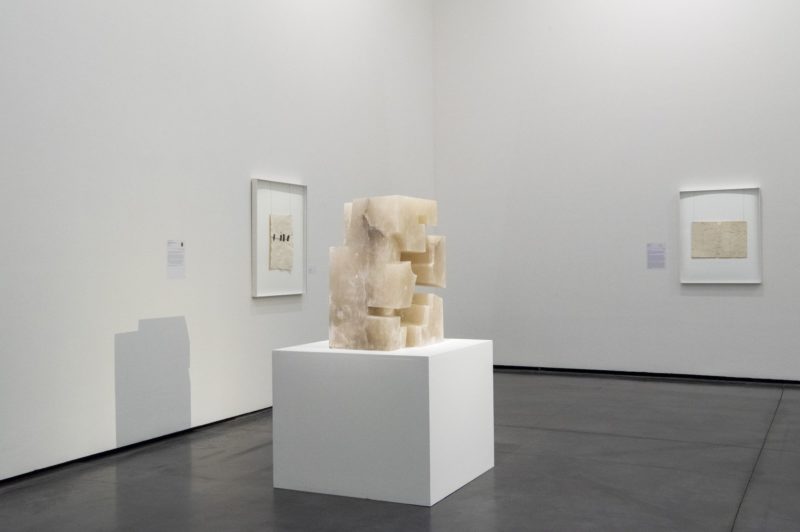
Eduardo Chillida
la gravedad insistente
In line with the monographic exhibitions recently dedicated to Antoni Tapiès, Daniel Spoerri, and Hessie, Les Abattoirs, Musée - Frac Occitanie Toulouse are continuing their exploration and rediscovery of the major figures of modern and contemporary art, presenting the exhibition Eduardo Chillida, Gravitación in association with the Fundación Eduardo Chillida-Pilar Belzunce.
From the 1950s, Spanish artist Eduardo Chillida (1924-2002) contributed to the renewal of the kind of sculpture that challenged the constraints of materials. Associating ironwork with modern sculpture, encompassing the surrounding space, he has thus contributed to a redefinition of sculpture, along with DavidSmith in the United States or Anthony Caro in Great Britain. In keeping with the artist’s previous work, who devised Peine del viento [Wind Comb], his masterpiece based on the Atlantic coastline, as a sculpture, an architectural space, and a site subject to the laws of the sea and wind, the exhibition presented at Les Abattoirs will broach themes focusing on the four elements. It brings together a series of works characterised by Eduardo Chillida’s concern with the notions of gravity, emptiness, and solidity. Beyond an aesthetic approach to sculpture, the project will illustrate the artist’s mission to create volumes that represent all kinds of physical, spiritual, and humanist sites.
Relating to the artist’s preferred themes, such as the limits of space and materials or the role of art in public space and in nature, the exhibition will bring together around sixty sculptures from 1948 to 1999. Similarly, the exhibition will assemble a selection of graphic artworks, including cutouts and collages that also experiment with space and materials. A selection of etchings of posters dedicated the human rights will highlight the artist’s humanist commitments. The exhibition will also be completed by a previously unseen collection of films and photographs. The arrangement of certain sculptures, particularly suspended sculptures, will attempt to engage a direct dialogue with the unique architecture of les Abattoirs, presenting a wonderful challenge to gravity.
This body of works is based on the collections of the Chillida-Leku Museum, stemming from the artist’s own studio archives, as well as from French and Spanish public and private collections such as that of the Museo Nacional Centro de Arte Reina Sofia in Madrid or the MACBA, Museu d’Art Contemporani de Barcelona.
The exhibition at Les Abattoirs will thus provide the means of rediscovering the work of this major artist in the history of sculpture. Presented as an echo of the collection of artworks from the CNES Space Observatory, this exhibition will also illustrate the extent to which Eduardo Chillida’s thought is also engaged with the primordial parameter of gravity and ways of overcoming the weight of materials in sculpture.
Artist’s Biography
Born in San Sebastián (Spain) in 1924, Eduardo Chillida left for Madrid in 1943 to begin his studies in architecture. Preferring to dedicate his time to the art of drawing, four years later he frequented a workshop space, where he produced his first sculptures. The following year was marked by his move to Paris and the discovery of the antiques conserved at the Louvre Museum. It was there that he created his first plaster casts and stone works. From 1950 onwards, his sculpture became totally abstract and the materials that he used diversified (wood, iron, steel, grog clay, concrete, cement, alabaster). Seeking to explore the possibilities of materials, no formats were off limits to the artist. In 1951, he returned to San Sebastián where he began work at a forge. Five years later, he devised his first exhibition at the Galerie Maeght. His work was notably the subject of texts by Gaston Bachelard. In 1958, he received the Grand Prix in sculpture at the Venice Biennale. His work soon expanded into public space, particularly with the installation Peines del Viento [Wind Combs] completed in San Sebastián in 1976.
The 1980s and 1990s saw the international consecration of the artist, who received numerous prestigious awards and honours. He also exhibited at major institutions, notably the Guggenheim Museum in New York in 1980, at the Venice Biennale in 1990, or the Picasso Museum in Antibes in 1991. In those same years, Chillida’s work was the subject of an array of international public commissions, enabling him to deploy monumentality and poetic force in his art. In 1987 he notably produced Elogia del agua[In Praise of Water], a 54-tonne artwork suspended above a body of water in Barcelona, in which it was reflected. Commissions continued, particularly in Seville where, in 1992, he created Hommage à la Tolérance [Monument to Tolerance] or in Santiago de Compostela in 1994, with Porta da Música [The Gateway of Music]. During the exhibition Chillida and Music presented in 1997 in Bad Homburg vor der Höhe (Germany), the artist also revealed his connection to music and poetry. In 2000, the Chillida-Leku Museum, now closed to individual visits, was inaugurated in Hernani, near San Sebastián (Spain), in the presence of the artist. A vast space spanning 12 hectares, it holds more than forty monumental works in steel and stone, in a site owned and designed by the artist. Eduardo Chillida died on 19 August 2002.
In pictures

"Eduardo Chillida. La gravedad insistente" aux Abattoirs (Toulouse)
